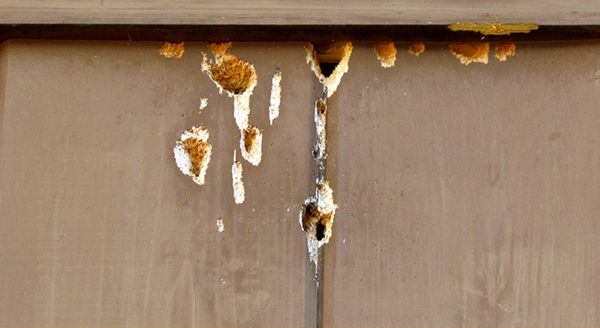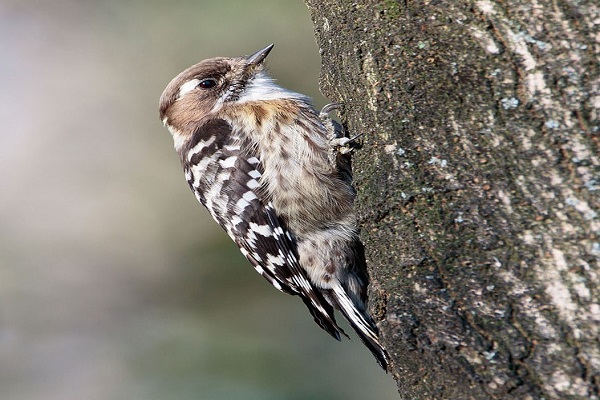Woodpeckers will always leave a mark for their fascinating pecking abilities. These birds are small to medium-sized and have strong bills that are used for drilling and drumming on trees. They are members of the family Picidae and are known to be the only bird that can peck without getting a headache. Most woodpecker species reside in tropical areas, with very few living in temperate regions.
While they’re always trendy for their pecking ability, woodpeckers do more than just drill trees.
Let’s look at some of the things woodpeckers do all day.
Woodpeckers Love to Drill Holes
A woodpecker’s favorite activity is probably drilling holes. Woodpeckers peck wood using their long, sharp beaks to make small or large holes in trees. The hole size will depend on the type of food the woodpecker is looking for.
Smaller holes are usually made to eat insects. The woodpecker will insert its bill into the hole and use its long tongue to flick the insects out. Larger holes are made to store food or to make a nest. The woodpecker will line the hole with soft materials like moss, leaves, or hair.
Some woodpeckers will even use their drilling skills to create music! The Northern Flicker, for example, will drum its beak on metal objects to make a loud noise.
The most common place to see these little creatures is on a tree trunk, specifically drilling dead trees.
Woodpeckers Drum To Communicate With Others
Woodpeckers use their ability for communication. If you hear woodpecker drums, they’re probably finding a mate or declaring their territory. The sound is made by the woodpecker rapidly hitting its beak against a hard surface. This behavior is more common in male woodpeckers since they need to attract females and keep other males away from their territory.
Woodpeckers also use their beaks to create a knocking sound to communicate with other woodpeckers. This sound is usually used to warn others of predators or to alert others of food sources.

Hunting And Foraging For Food
Woodpeckers will eat larvae, ants, spiders, and other small insects. While foraging for food, the woodpecker will use its long tongue to lap up the insects.
If you’re lucky enough to catch a glimpse of a woodpecker in action, you’ll notice they have a unique way of hunting. The woodpecker will sit on the tree and look around for prey. When it spots an insect, it lunges forward and catches the bug with its beak.
Establish Territories
Drumming is not only used for attracting mates but it’s also used to establish territories. Woodpeckers will drum on trees and other surfaces to let other woodpeckers know where their territory is.
The drumming noise is made by the woodpecker rapidly hitting its beak against a hard surface. This behavior is more common in male woodpeckers since they need to keep other males away from their territory.
Female woodpeckers are usually more subtle when it comes to establishing their territory. Instead of drumming, they will use their beaks to make a knocking sound. This sound is generally used to warn others of predators or to alert others of food sources.

Building Their Nest
Woodpeckers will build nests during nesting season. The male woodpecker will find a suitable nesting site and start drilling holes to make the nest. After the nest is created, the female woodpecker will lay between two and eight eggs. Both parents take turns incubating the eggs and feeding the chicks.
When the chicks are old enough, they will leave the nest and establish their territories.
Even though woodpeckers are small birds, they significantly impact the ecosystem. By eating insects, they help to control insect populations. And drilling holes in trees help aerate the tree and make them healthier.
So the next time you see a woodpecker, take a moment to appreciate all the hard work they do!
Woodpeckers’ Mating Habit
Woodpeckers are monogamous, which means they will mate with one partner for their lifetime. The breeding season for woodpeckers usually starts in late spring and lasts until early summer. During this time, the male woodpecker will find a suitable nesting site and start drilling holes to make the nest.
More About Woodpeckers
About 300 species of woodpeckers exist worldwide, and about 22 of those types live in the United States. The most common type of woodpecker in North America is the Downy Woodpecker. These little birds are black and white with a small patch of red on their heads.
The biggest woodpecker in North America is the Ivory-billed Woodpecker. These birds are about 20 inches long and have black feathers with white stripes running down their backs. The male Ivory-billed Woodpeckers also have a red crest on their heads.
Although this animal loves to live in forests, some species, like the Gila Woodpecker, can be found in deserts. And the Lewis’ Woodpecker can be found in open woodlands and forests.
No matter where they live, all woodpeckers have one thing in common: their long tongues! These tongues can be up to 4 inches long and are sticky, so they can help the bird lap up bugs.

Woodpecker Damage
Woodpeckers are undeniably intriguing. But along this, some people may view them as pests because they can damage homes and other structures.
The woodpecker’s beak is designed for drilling into trees. But this same beak can also leave dents in siding and shingles. And if the woodpecker continues to peck at the same spot, it can create a hole. More often than not, they don’t just leave a single hole but a series of holes that form an unappealing appearance.
To deter woodpeckers, you can try hanging shiny objects or wind chimes near the area where the bird is pecking. The movement and noise will startle the woodpecker and make it fly away. You can also try using an Ultrasonic Bird Repellent. These devices emit high-frequency sounds that only birds can hear.
While woodpeckers can be pesky, it’s important to remember all the good they do for the environment. So the next time you see one, take a moment to appreciate these fantastic birds!
Final Thoughts
Woodpeckers are famous for their wood-pecking ability. They drill holes to make music, establish territory, and build nests. These flying creatures act as biological control agents. By eating insects, they help to control insect populations.
While these animals are famous for this behavior, we’ve discussed that these creatures don’t just peck. They also use their beaks to make a knocking sound to communicate with other woodpeckers. This is usually done to warn others of predators or to alert others of food sources.
We hope you enjoyed learning more about woodpeckers and their behavior!
To explore more about woodpecker activities and their fascinating nesting habits, click here: woodpecker activities.
Woodpecker FAQs
Why do woodpeckers love to drum in trees, metal items, and houses?
Woodpecker drumming is a way to communicate with other woodpeckers. The woodpecker makes a noise rapidly, hitting its beak against a hard surface.
Why do woodpeckers drill holes into trees?
Woodpeckers drill holes so they can build their nests. They will also use this to establish their territory and find a mate during breeding. Aside from this, they are doing this in search of carpenter bees or insects that hide under the bark of trees.
How to deter woodpeckers from my property?
You can use bird netting, plastic owls, and wind chimes to deter woodpeckers from your property. It would help if you also try to make your property less attractive to woodpeckers by removing standing water and eliminating potential food sources.
You can also scare birds by displaying a replica of their predators or making loud noises.
Where do woodpeckers live?
Woodpeckers are found in woods all over the world. They usually use tree trunks of hollow trees or fallen logs as their habitat.














